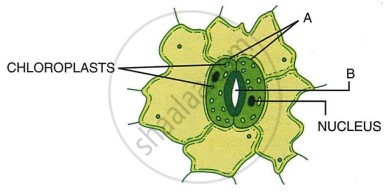Advertisements
Advertisements
प्रश्न
Given ahead is a diagram of an experimental setup to study the process of transpiration in plants. Study the same and then answer the question that follows:

- Name the colour of dry cobalt chloride paper.
- Is the experimental leaf a monocot or a dicot? Give a reason to support your answer.
- Why are glass slides placed over the dry cobalt chloride papers?
- After about half an hour, what change, if any, would you expect to find in the cobalt chloride paper placed on the dorsal and ventral sides of the leaf? Give a reason to support your answer.
उत्तर
- The colour of dry cobalt chloride paper is blue.
- Because the experimental leaf has reticulate venation and has more stomatal holes on its underside, it is a dicot leaf. This causes more obvious transpiration.
- To keep the strips in place, glass slides are set on dried cobalt chloride sheets.
- About half an hour later, the cobalt chloride paper on the dorsal side should turn less pink or take more time to turn pink. By comparison, the ventral side paper will turn pink faster. This variation arises from the higher rate of transpiration resulting from more stomata on the ventral surface of a dicot leaf than on its dorsal surface.
APPEARS IN
संबंधित प्रश्न
Name the following:
Any two parts of a leaf which allow transpiration.
State the functions of guard cells.
Draw a labeled diagram of the stomatal apparatus and label the following in it: Stoma, Guard cells, Chloroplast, Epidermal cells, and Cell wall.
Give Technical Term
Which side of the leaf has more stomata?
Name the following:
A plant having sunken stomata.
Complete the following sentence with appropriate word:
In Nerium, the stomata are present in _________.
Mark the most appropriate answer in the following:
In the mechanism of opening and closing of stomata, the important factor is
Name the three kinds of transpiration.
Give a reason/suitable explanation.
Leaves of some plants wilt during midday and recover in the evening.
Given below is the figure of a stoma. Study the same and answer the following questions:

- Label the guidelines A and B.
- Write the exact location of the above-mentioned structures.
- Mention one important role of structure A.
- Write three important roles for structure B.
- Redraw the same figure when structures A are in flaccid condition. When does the flaccid condition occur?
